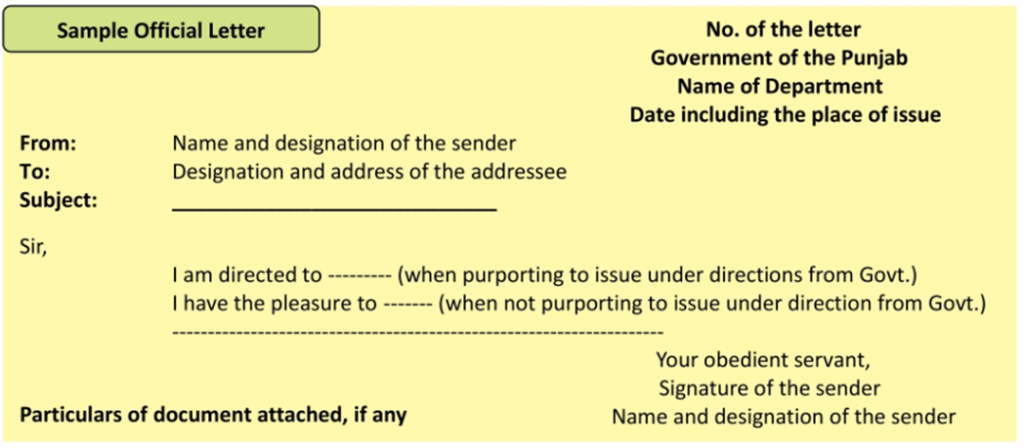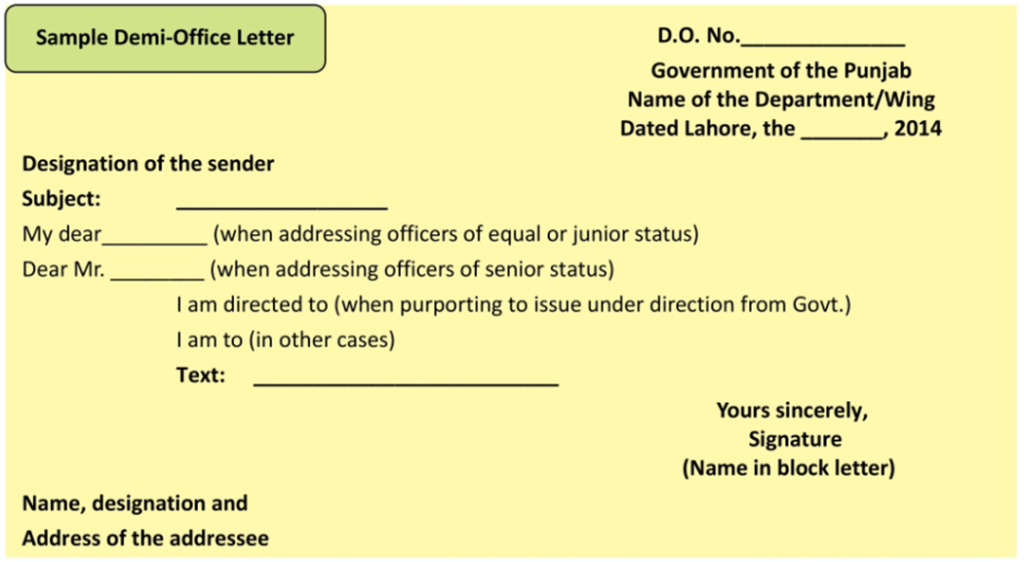OFFICIAL COMMUNICATION AND RECORD KEEPING
Handling of Official Papers
It is the duty of every member of the staff to protect official papers from rough or careless handling and to keep them in good condition. This rule also applies to the care and handling of other Government property in OFFICIAL COMMUNICATION AND RECORD KEEPING.
Acknowledgement of Dak
The clerk should acknowledge receipt of all types of dak delivered by hand giving his full signature, designation and date of receipt. He will also receive all communications intended for the office and pass them on immediately to the officer incharge. All covers, sealed or addressed to officer by name should be sent unopened to the officer who should open it himself or a member of his staff authorized by him in writing.
File
All the communication in an office regarding actions on different cases is done on files. Ordinarily every file shall consist of two distinct parts:
- the correspondence part; and
- the Notes or Noting part.
Correspondence part includes the receipts, drafts of letters and the office copies of the communications made with reference to the case. For the correspondence part of the file, the thick card-board covers bearing two punched holes shall, if available be used and for the noting file the thinner folded file covers shall be used. The subject and number of each file shall be written on both the file covers or typed on slips and pasted on them.
All pages of the correspondence part of the file should be serially numbered. The odd page number should be written on the right hand top corner of the page while the even numbers should appear on the top left hand corner on the reverse. The numbers should be written clearly and legibly and if numbering has to be changed due to error or interpolation of some material, the original serial number should not be crossed or over-written but simply scored out by a line drawn across it and the new number written thereunder.
Each communication in the correspondence file should be properly cross-referenced to facilitate prompt reference to the connected documents.
The latest communication on which action is being taken shall also be placed on the correspondence file at the end and page-numbered. It may also be flagged with a ‘PUC’ (Paper Under Consideration) label and referred to in the Notes file as “PUC at page–/C”. Reference to correspondence shall always be made page-wise as “P.13-14/C”, etc.
Noting is an internal processing of the case. The noting sheets in the Notes file shall be tagged inside the file cover at the left hand top corner so that it becomes possible to fold them backward and bring the last portion of the notes on top. The Notes file should not be page-numbered. It shall be serially paragraph-numbered continuously from beginning to References to Notes shall always be made paragraph -wise, “as para 19/N”, etc.
All incoming and outgoing communications shall be entered in red ink in the Notes file at the appropriate stage and given a paragraph number. Such entries shall be separated from the running Notes by horizontal lines drawn across the page.
Procedure for Assigning Subject Titles and Numbers to Files (record keeping)
Every file shall be given:
- a suitable subject title; and
- an appropriate number;
and these shall appear prominently on the file cover, places provided for this purpose Every office shall maintain an approved list of main subject headings serially numbered in respect of all matters dealt within the office. This list of main subject headings shall only give general subjects, e.g., in a section dealing with establishment matters, some of the subject headings may be as under:
(1) Recruitment of Staff
(2) Leave and Transfer
(3) Pension, etc.
The main subject headings shall be split into appropriate sub-headings and serially numbered. For example, under the main heading ‘Recruitment of Staff’, the sub -heading may be:
- Stenographers
- Clerks
- Typists
- Naib Qasids, etc.
The subject title of the file dealing with the recruitment of Clerks will then be:
‘Recruitment of Staff—Clerks’
The number of each file will indicate:
- The Office to which the file pertains.
- The serial number of the sub-heading.
- The serial number of the main list of headings.
- The year in which the file is opened.
The number of the file entitled ‘Recruitment of Staff–Clerks’ will, therefore, be ‘EDO. Education(Lahore)-1-3/2014″. The serial numbers of the files should run from 1st January to 31st December each year. A new series should be started each year but the main file headings allotted to particular subjects should, as far as, possible be retained.
Volume and Part Files
If the number of pages in a file exceeds 300, a new volume should be started, bearing the same number with the addition ‘Vol.-I” after it. No file should be opened unnecessarily. The opening of a part file should be avoided, as far as, possible. A part file may however be opened when the main file is not likely to be available for some time and the action cannot be held up mean while. When a part file is opened it should be given the same number as that of the original file and it should mention (Part File-l). The part file/files should be amalgamated with the main file as soon as the main file becomes available.
Referencing
No case shall be submitted by the Assistant or Clerk to an officer without previous papers to which references are made in the fresh case.
All the previous papers, rules and regulations, etc. to which reference is made in the fresh receipt should be indicated by giving the number of the pages in the margin in pencil and where necessary by flagging with alphabetical slips.
Noting on Files
A note should be recorded on a file only in a case which is to be put to a higher authority for orders. In such a case the noting should contain the following:
a. The facts of the case should be given in the noting in a brief and concise manner, it should also mention any mistakes/ mis-statement of facts in the paper under consideration.
b. The statutory procedure to be adopted in dealing with the case.
c. Any rules and regulations relevant to the case.
d. Any other related facts or figures.
e. The points for decision.
f. The suggested course of action.
All notes should be recorded on the Note Sheet of the file. No note should be written on the receipt itself. If an authority has already made any remarks on the receipt, the same should be reproduced on the note sheet before subsequent notes are recorded and the officer recording the note should affix his/her signature on the right side of the sheet at the end of the note. Notes exceeding half a page may be neatly typewritten. If handwritten, they should be easily legible. Notes should be broken up, as much as possible, into short connected paragraphs, each dealing with a particular point. Long sentences and a rambling style should be avoided. All notes shall be temperately worded and shall be free from personal remarks. If apparent errors are to be pointed out, or if an opinion has to be criticised, it shall be done in sober and appropriate terms. Special care should be taken in making observations on notes on senior officers and Ministers. The officer recording the note should affix his signatures and date on the right side of the note sheet at the end of his note along with his full name in type/print.
- The designation of the officer to whom a case is submitted should be indicated on the left side of the note below the signatures and date of the officers submitting the note.
- When the higher officer agrees with the note or recommendation, he may merely append his signature.
DRAFTING
A draft communication should convey the exact intention of the orders passed both in letter and in spirit. The language used should be clear and simple. Long sentences and repetitions, whether of words, expressions or ideas should be avoided. In the case of lengthy and complicated communications, the main points should be summarized in the concluding paragraph.
Different Forms of Drafts
A brief overview along with the samples / formats of the important forms of communication commonly used in Government Offices is given below.
- Official Letter
An official letter form should normally be used for correspondence with the Federal Government, other Provincial Govts; Pakistan Missions abroad, Foreign Missions in Pakistan and High Court, etc. It is not used for correspondence between different departments.

- Office Memorandum
Memorandum is normally used for correspondence with subordinate and higher offices or the office of the same status within the same Government. It does not contain salutation and complementary closing / subscription.

- Demi-Official Letter
Demi-Official letter is addressed personally to an officer by name and is written in first person. It begins with salutation (Dear/ My Dear) and terminates with subscription (Yours sincerely).
It is written when the personal attention of the addressee is required in a particular matter to ensure expeditious action.
In salutation part, the following points may be noted:
- When writing to the higher offices the name of the officers should not be used; instead the designation of the officer should be used.
My Dear Director
My Dear DEO
- When writing to lower or equal formations the name may be used Dear Mr. Qureshi

- Unofficial reference or UO letter
An un-official reference is normally used for making inter departmental references, particularly when files are sent to other departments for information or advice.

- Order
This form of communication is used to convey different orders /instructions such as appointment, sanctions, disciplinary decision, etc.

- Endorsement
This form is used to forward the original order or the applications, etc. to the quarters concerned (the addressees) for information and necessary action.
Note: The main copy will be signed by the Head Teacher leaving the endorsement without signature but the endorsed copy/ copies will be signed by the HT or DY. HT marking the main letter as SD/ at the signature place.

- Application
Application is a request made to some authority for provision of some facility, job, leave, etc. It is written in first person. It contains the following main contents:
i. Official designation of the addressee ii. Salutation iii. Subject
iv. Main text – detail of the request v. Subscription vi. Name and Address with Date

- Invitation Letter
An invitation letter is a form of written communication which is used for requesting people to attend a function. It must contain the date, place and time of the function and it should explain the nature of function.

Office Records and Record Keeping
The office record is the back bone of every office. It contains all sorts of information about offices and schools and the activities performed in it.
Record keeping is receiving, classifying, arranging and preserving the incoming and outgoing information about the on-going matters, assets, liabilities and the personnel of an institution/office systematically placed in order to reproduce it promptly for any future reference. It also includes the record about the students.
The sources of the office / school record
| Cash Register Attendance register Property Register Cash Book Accession Register Conduct & Discipline register Postage stamps register Casual leave account register The Punjab Education Codex Examination Register Library books issue register | Visitor’s Book Stock Register GP Fund Register Income & Expenditure Register Diary & Dispatch Registers Character Roles & Personal files Acquaintance Roll Contingent Register Log books of the vehicles Admission & withdrawal register |
All the incoming and outgoing information of an office, besides all actions taken by the Head of the institution/office recorded in a register, a book or a file, form the record. The following books, registers and files are maintained as a record in different offices and schools. (Source: Punjab Education Code)
Duration for record keeping
Different records which are maintained in offices and schools are needed to be kept for specific periods of time before destruction. Time lines for maintaining different records are given below after which these records need to be weeded out.
| Audit reports | 5 Years | Traveling allowance bills | 3 years |
| Syllabuses | -do- | Exam results (Departmental) | -do- |
| Visitors books | -do- | Register of postage stamps | -do- |
| Rustication of boys | -do- | Purchase and supply of liveries to peon | 3 years after last supply |
| Papers regarding purchase of seeds etc. | -do- | Vouchers of contingent bills not exceeding Rs. 100 | 3 years after audit |
| Attendance registers | -do- | House examination results | 2 years |
| Statements of fees realized and credited in the govt. treasury | -do- | Annual repairs to buildings | -do- |
| Casual leave cases and statements | 1 year | Register of issue of library books | -do- |
| Annual results and promotion of students | -do- | Stationery Registers | 3 years after being checked by auditor |
| Applications for exemption or remission of fees | -do- | ||
| Vouchers of all sorts | -do- | ||
Note: The aforementioned information has been taken from circular No. 564 DPI’s C. M. No. 18083-R, dated 310-34, to the Divisional Inspectors and Circle inspector of Schools in the Punjab.
Procedures
To write off irreparable / unserviceable items
A list of such Items be prepared and sent to DEOs.
DEO (E) may visit the school to physically verify the items in the list and pass orders for writing them off and their disposal through open auction by the Head teacher.
Later on, all the written off items should be disposed off through public auction by the Auction Committee of the school constituted by the Head Teacher, and the proceeds (money received from auction) should be deposited in the govt. treasury/ National Bank
For repair / replacement of broken items during use in an Elementary School
A list of such items should be prepared in the next meeting of the School Purchase Committee (or School Council as the case may be) for its approval to carry out repairs/replacement out of Farogh – e-TaIeem funds (or School Councils Funds as the case may be)
Get the items repaired / replaced locally through the School Purchase Committee (or School Council) or any other Committee constituted under govt. instruction for this purpose.
All the vouchers must be maintained carefully by the Head teachers for audit purposes
| References: Manual of Secretariat Instructions Punjab Education Code Rules of Business, 2001Circular No. 564 D.P.I’s C. M. No. 18083 -R, dated 310-34, to the Divisional Inspectors and Circle inspector of Schools in the Punjab |





gi3nma